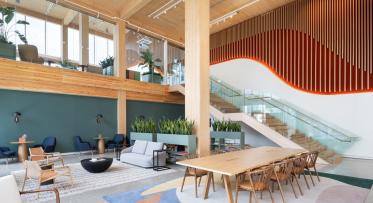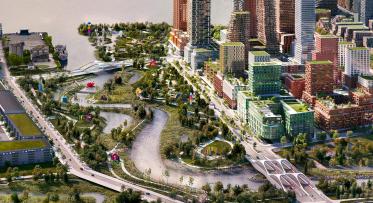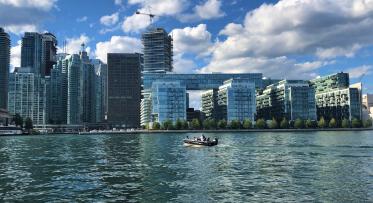Underpass Park Competes in World Cities Day Challenge
Underpass Park, the uniquely urban park we created beneath the Richmond and Adelaide overpasses in the West Don Lands, was a finalist in the Guardian’s first World Cities Day Challenge. (Image courtesy of Spencer Wynn)
POSTED: NOVEMBER 12, 2014
BY: PAUL FRENCH, DIAMOND SCHMITT ARCHITECTS (GUEST CONTRIBUTOR)
When The Guardian newspaper in the UK launched a World Cities Day Challenge in September, my thoughts went to the West Don Lands. Specifically, that small patch of inspiration beneath the Richmond Street ramp off the Don Valley Parkway called Underpass Park.
The challenge went out to anyone from anywhere to submit an idea from their city that could alleviate common urban ills elsewhere. The blight of elevated highways is ubiquitous enough, creating dank, unwelcoming space beneath the din of traffic. These air-borne arteries slice through communities and create pockets of neglect, often in areas of prime downtown real estate.
I thought Underpass Park’s inventive transformation of such a space was a good candidate for this global initiative. Amid concrete beams and columns, there are now basketball courts and benches, a skateboard park, public art, a playground with swings and a playful climbing structure. Waterfront Toronto commissioned Vancouver landscape architects PFS Studio to repurpose the space, to make it inviting and help stitch together burgeoning new neighbourhoods sprouting in the eastern part of downtown Toronto.



Underpass Park transformed a dark and intimidating space into a playground for residents of all ages, including basketball courts, a skatepark and climbing equipment.
When I visited Underpass Park, the users evidently appreciated the new amenity, boasting with some pride that it was in their neighbourhood and how – by design – somewhat hidden from view from the rest of the city. This is, after all, a playground beneath a bridge. And that, said a few enjoyers, is its beauty. Where else can you shoot hoops or skateboard in the rain or snow? The highway’s underbelly provides year-round shelter. A teen-ager spoke eloquently of the smart use of space. He told me about the attraction at night, which I otherwise wouldn’t have noticed. To keep the park connected with the community, an attractive coloured light display highlights the mundane, turning concrete and steel into palettes of multi-hued displays. As a consequence, people use this space well into the night. A public art feature called Mirage by artist Paul Raff also serves to invite the public to explore.
To best illustrate Underpass Park to the judges of this global competition, I made a 2 min 30 sec video of my interviews at the park.
October 31st was the first World Cities Day as declared by UN Habitat. The Guardian took the initiative to make it real. In all, 36 cities were chosen and lined-up on a website for public review and the judges’ critique. You can see the entire presentation on The Guardian’s site.
It was fascinating to watch as the projects were presented in real time; it felt almost like New Year’s Eve, only instead of pyrotechnics, we followed fireworks of ideas that swept the globe. There were no prizes – only bragging rights. The submissions included both the physical – designed and built projects – as well as more idea-based solutions, like Seville’s rooftop gatherings and Tallinn’s call for community collectives. Porto Alegre in Brazil won the judge’s favour with Which Bus Stops Here – a bus stop poster campaign to better inform commuters of precisely that.
As an initiative, World Cities Day started small. Clearly, it has the potential to gain interest and attention as our urban populations expand and where small initiatives such as Underpass Park can shed some light on providing solutions that resonate around the world.
About the author
Paul French is Director of Communications at Diamond Schmitt Architects, an award-winning architectural firm based in Toronto.




